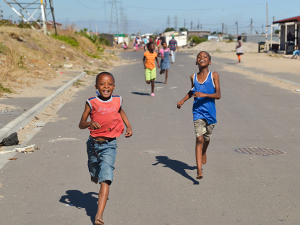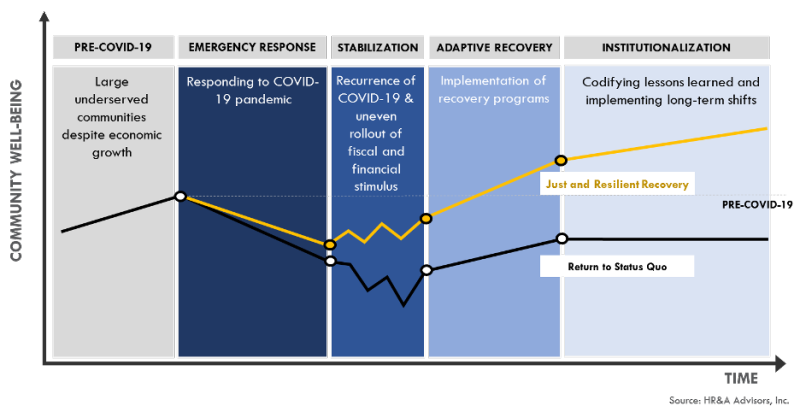A ‘Just and Resilient Recovery’ framework for international donors and financial institutions
 Even as some of the most severe COVID-19 outbreaks subside, the pandemic continues to spread around the world, with 11.5 million cases confirmed and more than five hundred thousand deaths as we write. Roughly two-thirds of all new confirmed cases are in developing countries, with Latin America alone accounting for over a third of new confirmed cases.
Even as some of the most severe COVID-19 outbreaks subside, the pandemic continues to spread around the world, with 11.5 million cases confirmed and more than five hundred thousand deaths as we write. Roughly two-thirds of all new confirmed cases are in developing countries, with Latin America alone accounting for over a third of new confirmed cases.
The economic disruption that the virus and measures to contain it have brought to developed economies will be dwarfed by the consequences of similar efforts in the developing world. According to forecasts from the World Bank, COVID-19 will, by the end of 2020, push an additional forty-nine million people into extreme poverty. That represents an increase of 8 percent and would be the first increase in extreme poverty globally since the Asian financial crisis in 1998. The projections suggest that sub-Saharan Africa, where an additional twenty-three million people could fall into extreme poverty, will be hardest hit, with Latin America and the Caribbean and South Asia splitting the balance.
Designing emergency response programs, fiscal and monetary stimulus, and long-term economic recovery plans to address the effects of the pandemic will be more challenging in places where the economic damage is deepest and existing inequality the most acute. Indeed, a combination of already-stagnant economies, tight fiscal conditions, and weak institutional capacity has created a perfect storm in many developing countries.
A ‘Just and Resilient Recovery’ Framework for International Donors and Financial Institutions
Against this backdrop, the mitigation of economic and social damage in many countries has been left to global philanthropies and international financial institutions. The G20 countries have agreed to a useful, if limited, suspension of debt service for the poorest countries, and the World Bank moved quickly to mobilize $160 billion in new and repurposed capital, which was followed by other multilateral development groups. We believe, however, that these efforts will be insufficient if these and other institutions do not take a structured approach to understanding needs on the ground and the prioritization of the implementation of their actions.
While most actors have rightfully focused their immediate attention on public health measures and efforts to strengthen the safety net, as cities and regions start emerging from quarantine and effective therapies and vaccines are developed they will need to collectively address the underlying economic and social challenges that have made COVID-19 so devastating and destabilizing for the most vulnerable groups in society.
Based on our experience with previous natural, economic, and humanitarian crises, we have developed a framework to help guide cities and communities on the path to a more “Just and Resilient Recovery.” The framework calls for public and private institutions to organize and coordinate their COVID-19 recovery efforts around the four sequential phases illustrated below.

The time for planning and coordinating fiscal policy efforts is now. Global donors and financial development institutions should start planning and prioritizing how and where their assistance will be directed to ensure that countries and cities that receive that assistance can use it to create a more just and resilient “next” normal that addresses some of the structural inequities of the old normal, including poverty, informality, and discrimination.
Over the coming weeks and months, as institutions continue to organize their internal resources and begin to develop road maps for the next phase of the recovery, they should consider the following:
Assess the economic disruption: As lockdowns ease and more evidence and data becomes available, institutions should develop a more granular understanding of the economic and fiscal impact of the virus in the countries and jurisdictions they serve. This can be done at scale with a dynamic model that takes into consideration baseline economic conditions pre-crisis, the scope of containment measures taken and the degree to which they have been enforced, the level of unemployment (formal and informal), and, where appropriate, the fiscal measures already taken by governments to mitigate the economic impacts of the virus. The model should also take into account the compounding effects of future natural disasters and the percentage of the population lacking access to clean water and waste treatment infrastructure. This more granular understanding of the economic damage resulting from the virus will enable institutions to better calibrate the magnitude and speed of the response required in different countries, regions, and communities.
Understand needs and opportunities: Supported by such an assessment, institutions need to understand which economic sectors and segments of the population have been most impacted and what the opportunities are to rethink how to rebuild and create employment opportunities in more productive industries. A focus on sectors with high economic multipliers such as technology, research, and advanced manufacturing should be seen as an opportunity to bring substantial numbers of workers into the formal economy and prepare large segments of the population for the future of work.
Map resources: Once the economic damage and the opportunities for a more just and resilient economic recovery have been identified, institutions need to think carefully about how to leverage resources from other countries, donors, and the private sector. The capital from donors and multilateral development banks should be seen as a “filler” that closes financial gaps and addresses market failures, catalyzing private investment and participation. Understanding the potential to effectively leverage private-sector participation under the current short-term capital commitments from development banks will be critical. That includes exploring more active participation in public-private concessions, providing availability payments, and making backstop guarantees to de-risk projects.
Prioritize areas of investment: With an understanding of the needs, opportunities, and resources available in the short- and mid-term, institutions should be able to prioritize the allocation of resources across countries and sectors in an efficient way and provide guidance and direction to specific country offices and divisions accordingly. Such a prioritization should consider which industries and clusters are best positioned to increase productivity and create jobs and how communities can benefit from such growth in an inclusive manner. This could include investments in digital infrastructure that pave the way for greater innovation and technology, public transportation to make job opportunities accessible to everyone and cities more sustainable, and resilient infrastructure designed to mitigate the shock and disruption of future climate-related disasters.
The global development community has a generational opportunity to substantially transform the economies of the poorest countries, leveraging resources from all sectors, with a focus on investments that boost productivity and eradicate secular inequities and establish a precedent for a Just and Resilient Economic Recovery. Let’s not let that opportunity go by the wayside.






